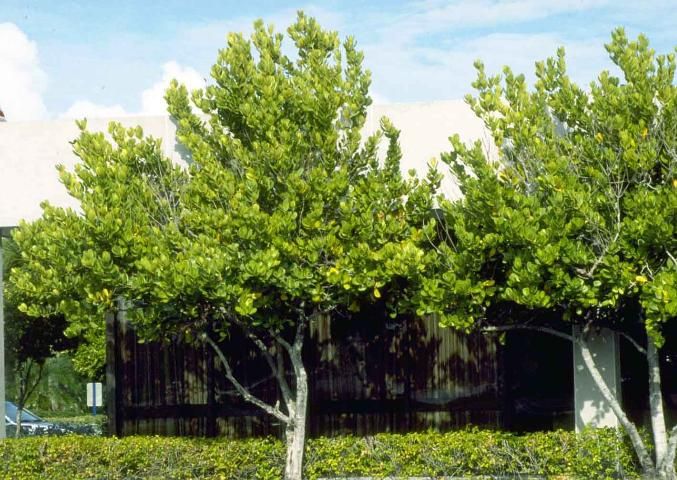Introduction
A very tough tree well-suited for coastal and seaside locations, Madagascar olive is an attractive, upright oval, evergreen with six-inch-long, leathery, olive green leaves and a high tolerance for salt and wind. The crown appears to stay well-formed even right up on the coast where it is exposed to salt spray. It reaches a height of 20 feet with a 15 to 20-foot-spread. The inconspicuous but fragrant, small yellow blooms are followed by one-inch-diameter, bright yellow fruits, turning to dark purple, with a sweet, edible, cream-colored flesh, which adds to the tree's ornamental value. The dropping fruit may be undesirable to some people when planted near walks or pavement, but properly located in a bed or lawn is of little concern.

Credit: Ed Gilman, UF/IFAS
General Information
Scientific name: Noronhia emarginata
Pronunciation: nor-RAWN-ee-uh ee-mar-jih-NAY-tuh
Common name(s): Madagascar olive
Family: Oleaceae
USDA hardiness zones: 10B through 11 (Fig. 2)
Origin: not native to North America
Invasive potential:has been evaluated using the UF/IFAS Assessment of the Status of Non-Native Plants in Florida's Natural Areas (Fox et al. 2005). This species is not documented in any undisturbed natural areas in Florida. Thus, it is not considered a problem species and may be used in Florida.
Uses: reclamation; street without sidewalk; deck or patio; screen; specimen; espalier; fruit; container or planter; parking lot island < 100 sq ft; parking lot island 100-200 sq ft; parking lot island > 200 sq ft; sidewalk cutout (tree pit); tree lawn 3-4 feet wide; tree lawn 4-6 feet wide; tree lawn > 6 ft wide; urban tolerant; highway median
Availability: not native to North America

Description
Height: 20 to 25 feet
Spread: 15 to 20 feet
Crown uniformity: irregular
Crown shape: oval, vase
Crown density: dense
Growth rate: slow
Texture: coarse
Foliage
Leaf arrangement: opposite/subopposite (Fig. 3)
Leaf type: simple
Leaf margin: entire
Leaf shape: obovate, elliptic (oval)
Leaf venation: pinnate, brachidodrome
Leaf type and persistence: evergreen, broadleaf evergreen
Leaf blade length: 4 to 8 inches
Leaf color: green
Fall color: no color change
Fall characteristic: not showy

Flower
Flower color: yellow
Flower characteristics: not showy

Fruit
Fruit shape: round
Fruit length: .5 to 1 inch
Fruit covering: fleshy
Fruit color: purple, yellow, green
Fruit characteristics: does not attract wildlife; showy; fruit/leaves not a litter problem
Trunk and Branches
Trunk/bark/branches: branches droop; not showy; can be trained to one trunk; thorns
Pruning requirement: needed for strong structure
Breakage: resistant
Current year twig color: green, brown
Current year twig thickness: thick
Wood specific gravity: unknown
Culture
Light requirement: full sun, partial sun, or partial shade
Soil tolerances: clay; sand; loam; alkaline; acidic; well-drained
Drought tolerance: high
Aerosol salt tolerance: high
Other
Roots: not a problem
Winter interest: no
Outstanding tree: no
Ozone sensitivity: unknown
Verticillium wilt susceptibility: unknown
Pest resistance: free of serious pests and diseases
Use and Management
Growing easily in full sun or partial shade, Madagascar olive is quite adaptable to a wide range of soils. It works well as a dense screen or windbreak, and can form an ideal specimen or framing tree for landscapes with limited room after the lower branches are removed. A cluster of trees creates a handsome, informal grouping. This is a tough small tree which is suitable for many locations. Use it to create shade on a patio or grow it in a large, heavy container on a deck. The small size makes it ideal for planting along streets where there are overhead power lines.
Propagation is by cuttings or seed.
Pests and Diseases
No pests or diseases are of major concern.
Literature Cited
University of Florida, Institute of Food and Agricultural Sciences. 2018. "Assessment of Non-native Plants in Florida's Natural Areas" (https://assessment.ifas.ufl.edu, 4/29/2019) Gainesville, FL, 32611-4000, USA.
